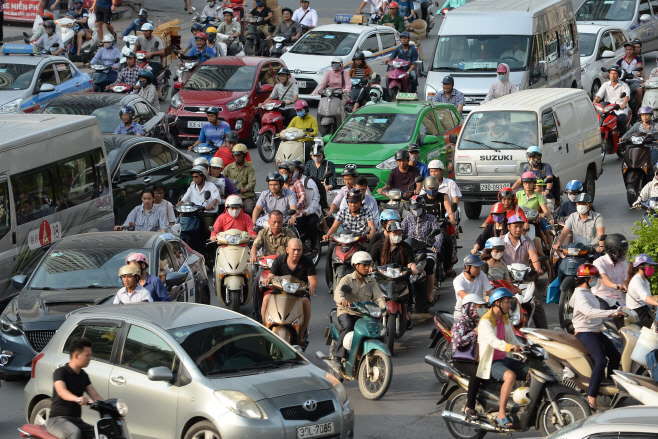
BEST PRACTICAL TIPS FOR DRIVING SAFELY IN THAILAND
CONTENTS
I. Why is it important to prepare for Thai traffic situations?
II. How is Thai traffic different?
III. Thai authorities' response to Thai traffic behaviour
IV. How and why do most accidents happen in Thailand?
V. How to stay safe?
Traffic rules in theory apply internationally and so also in Thailand, but traffic behaviour in Thailand is rather different mainly because of cultural and development factors. Thai people tend to bend (or break) the rules, so in daily practice traffic rules aren't observed in the same way as in more developed countries and if you want to stay safe, you'd better be aware of how things are different here.
This is all the more important because Thailand is year-and-again amongst the top countries of having traffic accidents in the world (!).
What makes Thai traffic behaviour different from what you're used to in your own country has everything to do with how Thai culture is and the way the country is organised. In this article, I am going to show you how certain features of Thai culture affect actual traffic behaviour, but you can also use this article reversely: by understanding Thai-style traffic you can actually understand more about how Thai people think.
I. Why is it important to prepare for Thai traffic situations?
Thailand has for many years in a row ranked amongst the top countries of having traffic accidents in the world, especially for motorcyle accidents, according to studies from the WHO.
The Thai authorities also monitor the number of traffic accidents and fatalities, especially in the so-called Seven Dangerous Days of the Year, which is the period around Western New Year, and the period around Thai New Year Songkran. Every year, tens of people die per day during these dangerous periods and hundreds are injured, with Chiang Mai as one of the most dangerous provinces in the entire country.
Many foreigners are involved in traffic accidents in Thailand, for the simple reason that they trusted international rules and were not accustomed to the ways in which Thai people drive.
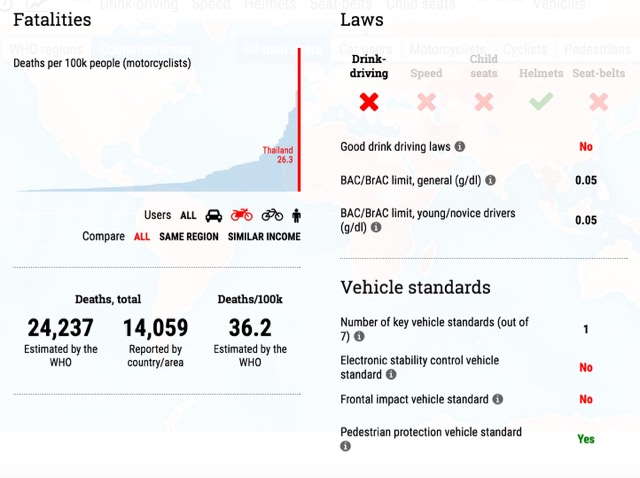
II. How is Thai traffic different?
1. RANGE OF RESPONSIBILITY
The most important factor that influences all Thai traffic behaviour is what I call a Thai driver's 'Range of Responsibility'. A Thai driver's Range of Responsibility is what he (should) pay attention to in Thai-style, basically it's all that appears in his eyesight without turning his head, so we're talking about an angle of roughly 90-140 degrees in front of the vehicle.
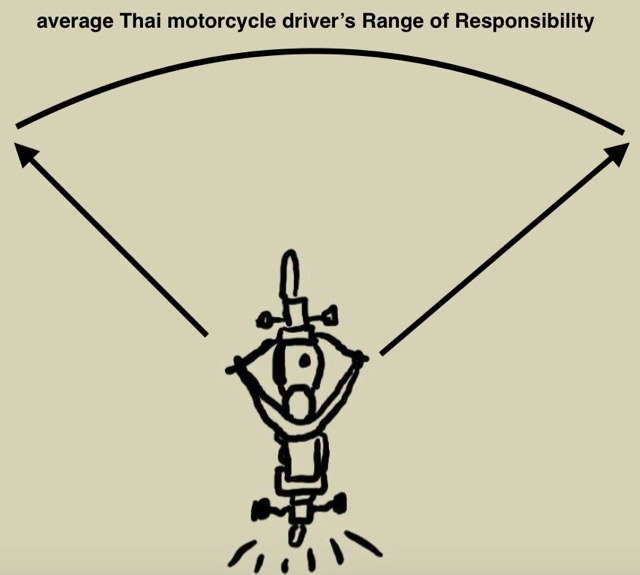
So, while an international driver's Range of Responsibility is 360 degrees, the Thai driver's practical Range or Responsibility is at most about half of that.
According to international traffic rules, you have to check your mirrors and do a shoulder check when you change lanes, make a turn or in other circumstances, but because Thai people are inherently lazy, most of them fail to do that consistently. And because most Thai people don't make sufficient use of mirrors and shoulder check, there is an implicit collective understanding that a driver's main (or even only) responsibility rests within the span of his eyesight in front of him, his Range of Responsibility.
To put it simple, everyone basically cares (mostly) about what is in front and as far as the corners of the eyes can see, almost without turning a head.
Does that work? Well, it works in many cases and in a way it could be an efficient way to deal with traffic but the one disadvantage this lazy system has is that it doesn't sufficiently cover the so-called blind angle (or blind spot) that is located somewhere behind you and at your sides, so this becomes a grey area between the driver in front and the one in the blind angle and thus creates a risk for accidents to happen.
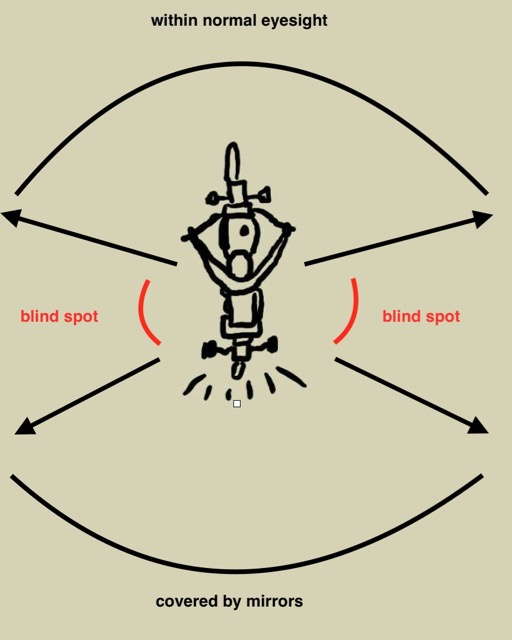
BECAUSE THE RANGE OF RESPONSIBILITY IS THAI TRAFFIC'S MAIN "RULE" IT INFLUENCES ALL, GOOD AND BAD
Because of the Range of Responsibility is a Thai driver's implicit leading principle, everything else depends on it. It almost doesn't matter who's right or wrong according to the official rules, in practice everyone acts according to this principle.
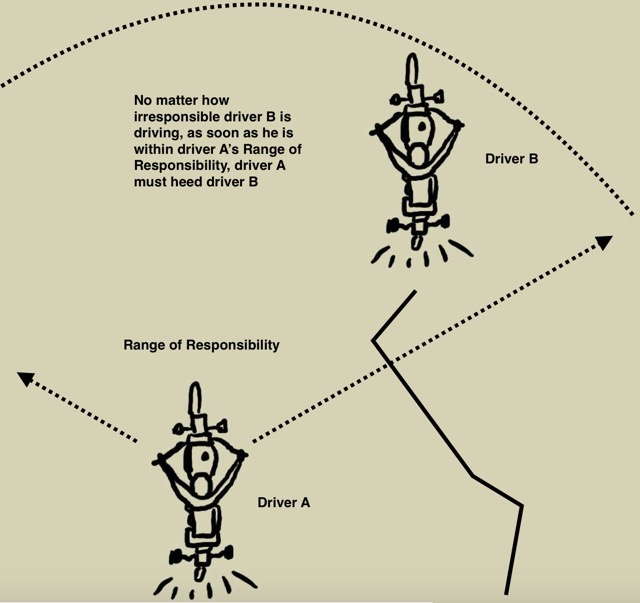
For example, you could make signs that you want to move sideways from one lane to another or make strange movements and you'll find, to your surprise perhaps, that someone behind you is waiting for you to cross lanes, even though according to international rules you were supposed to wait for the person behind to pass you first or even though you are acting wrongly according to the real rules.
"You're in my sight so I adapt to you" is the practical solution that Thai traffic society has adopted.
Another example is that Thai drivers tend to overtake someone just before a turn, which in international context doesn't make sense, creates dangerous situations and also obstructs the flow of traffic, but it does make sense in Thai context because when driver B suddenly appears in front of driver A, it means that now driver A has to take driver B into account because B is in A's Range of Responsibility.
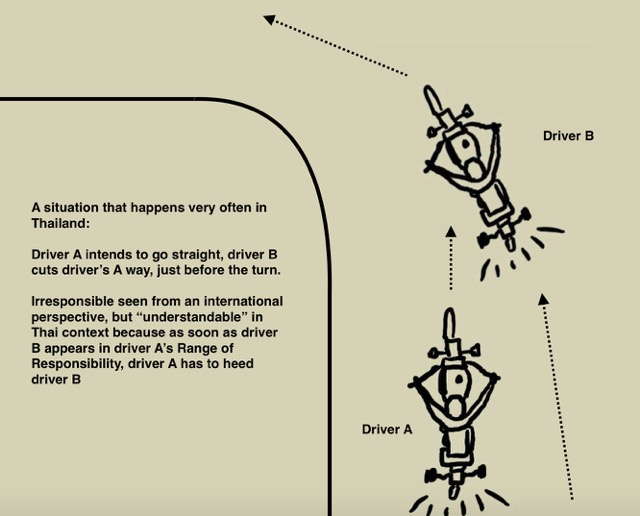
I believe that even the Thai police and Thai insurance companies make (implicit or explicit) assessments based on a driver's Range of Responsibility, so that some accidents are blamed on the person behind while in an international context that person would have been right.
So the Range of Responsibility is really important and it actually conflicts with international traffic rules as you're probably used to.
2. ADAPTING TO EACH OTHER RATHER THAN FOLLOWING THE RULES
Another important implicit feature of Thai traffic behaviour which has everything to do with Thai culture is that Thai drivers continuously adapt to each other rather than rely on real traffic rules. In other words, it's more important to watch and adapt than to trust and follow the rules.
This collective implicit understanding in Thai traffic actually made me fail my Hong Kong motorcycle driving test, because I picked up this Thai habit of stopping or moving very slowly when the traffic situation appears unclear, while in international context you are supposed to rely on other drivers acting according to the rules and keep your speed.
Adapting to each other continuously is a typical Asian cultural feature that can be witnessed to its maximum in Vietnamese traffic, that consists of rivers of scooters flowing down the streets like a school of fish. Japanese people show adaptive yet at the same time extreme law-abiding behaviour, but like other Asians are also a group-oriented people where the harmony of the group are more important than the rights of an individual. In stark contrast to that, Western people tend to be more strict and rely on rules while insisting on their individual rights, so here are some fundamental differences which clearly play out even in traffic situations.
Thai people aren't exactly amongst the most law-abiding people in the world, rules are publicly acknowledged but are often easily bent in public or broken in secret. In a similar way that many Thai treat a promise as being a mere intention that can be put aside using any (lame) excuse, rules, laws and regulations are often treated merely as guidelines that can be deviated from when you need to.
NOTHING REALLY MATTERS EVERYTHING IS EMBRACED BY THE ALL-ABSOLVING MANTRA THAT VIBRATES THROUGH THAI SOCIETY: MAI-PEN-RAI SABAI-SABAI
In traffic, you can witness that in more cases than I can describe: parking right at corners (with red-and-white pavement signs), driving against the traffic flow, driving without lights on and so on. It all doesn't matter, it's is warmly embraced by the all-encompassing, all-absolving mantra that vibrates through Thai society: mai-pen-rai, sabai-sabai. Even by law enforcers.
For example, at intersections without traffic lights typically you can observe that normal traffic rules don't apply: traffic from the left is supposed to have priority, but in practice people just watch each others behaviour and the one who pushes on first often goes first. It is a constant give and take (sometimes more take than give), but in a more or less adaptive organic group process, rather than a strict demanding and judging based on rules.
Thai people don't trust the rules, don't rely on laws, and don't trust each other, but instead they are flexible to the situation and adapt.
3. HINDERING TRAFFIC FLOWS IS COMMON
In Western driving schools you should have learned that you have to do what you can to avoid interrupting the flow of traffic, so you wait until cars pass before you park or get out of a parking space, you don't stop at the side of the road when that will block the entire lane, you don't drive slowly where you can drive a decent speed and you make turns quick enough. Much of this is nearly alien to Thai style traffic where the concept of avoiding hindrance to others is nearly absent. This is especially so for tuk tuk and red pick up trucks, which behave like a mafia anyway, but also for other uneducated road users.
Driving 20km per hour, making extremely slow turns, temporarily parking the vehicle in the middle the road thus blocking all traffic behind are all very common in Thailand.
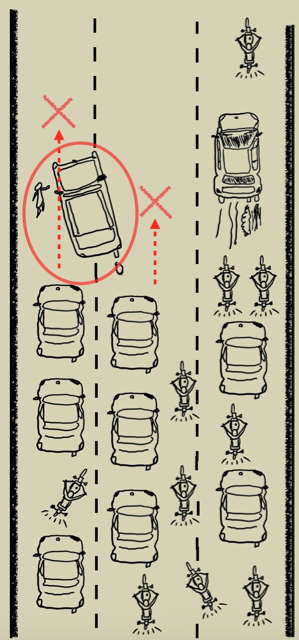
This again is for a large part due to cultural factors: time isn't as valuable as in Western societies, there is less of a hurry, there is no concept of opportunity costs, and you're supposed to adapt and accomodate each other rather than claiming your rights.
4. CUTTING CORNERS
You probably have learnt before how to await traffic on a main road to pass first and then make a proper turn into that road, so you want to expect the same from your fellow road users, but in Thailand it's different.
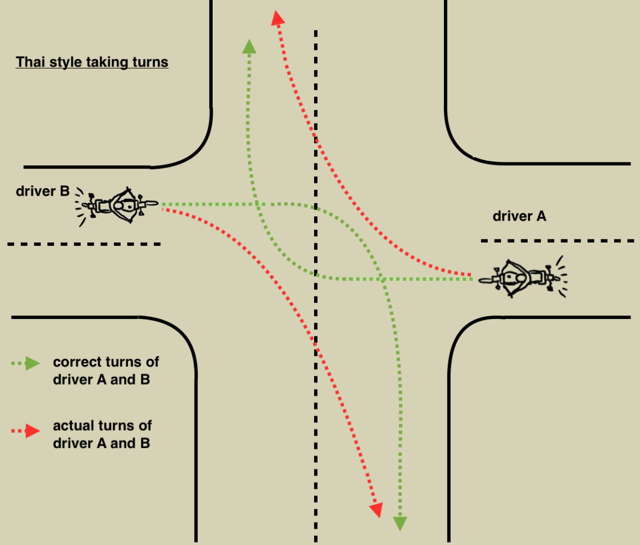
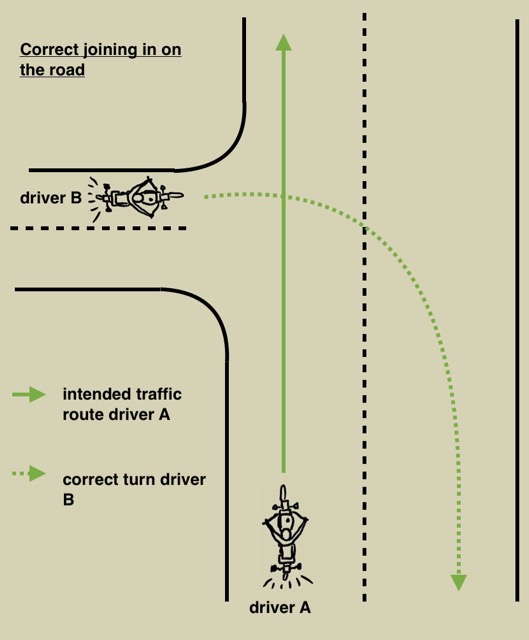
Thai drivers like to cut corners wherever they can, not just in traffic but also in work and study, so you have to anticipate incorrect traffic behaviour like this:
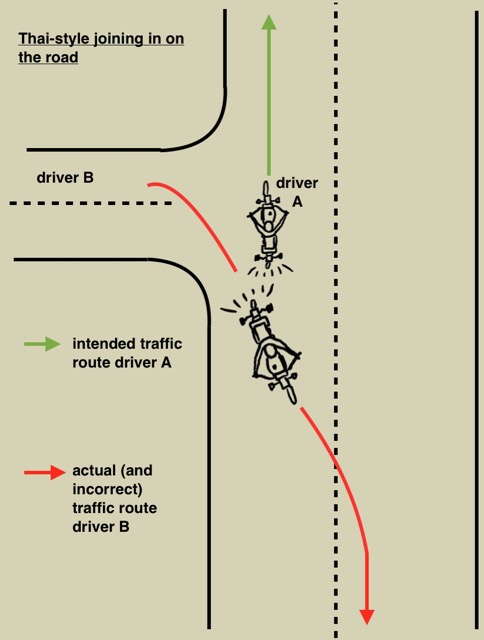
When you're driver A and you see someone trying to join the main road like this, at first you might think the other driver is going to crash into you, and there is a risk to that, but all you have to do is to maintain your speed and be predicable because driver B is making his calculations to join in based on predictable traffic behaviour of other road users.
CUTTING CORNERS IS THE CORNERSTONE OF THE THAI SKILLSET AND INGRAINED IN THE WAY THAI PEOPLE DO THINGS
Cutting corners is a habit (or skill!) that Thai people have not only in traffic, but in many other aspects of life too: work, social life, study, language. The focus is not on doing things the correct way, but on getting your things done the easier way. That there are consequences, risks and disadvantages to doing things not in the right way is not something most Thai people worry about, as long as you can get away with it now it's good enough.
I've been working with Thai workers for years, even when fixing a leaking water pipe workers prefer to go the quick-and-dirty way taping things away or 'solving' it with lots of silicon, which does the job for a few months, but you know it's not going to last.
Cutting corners is the cornerstone of the Thai skillset and engrained in the way Thai do things.
5. ANONYMOUS SELFISHNESS VERSUS PERSONAL KRENG-JAI - WHOEVER BLOCKS GOES FIRST
While Thai people are generally very polite when meeting one-on-one, so in private individual contacts, they can be rather rude when faced anonymously in traffic. Selfishness is the norm, gentleman behaviour is nearly non-existent, flashing lights don't mean allowing another to go first but are meant as a warning that the driver is passing at a high speed and you'd better stay clear.
Lack of signalling or too late signalling before making a turn is another example of selfish behaviour.
Thai culture teaches to be 'kreng jai' (เกรงใจ) to each other when the other party is known, but people like to take advantage of each other when unknown.
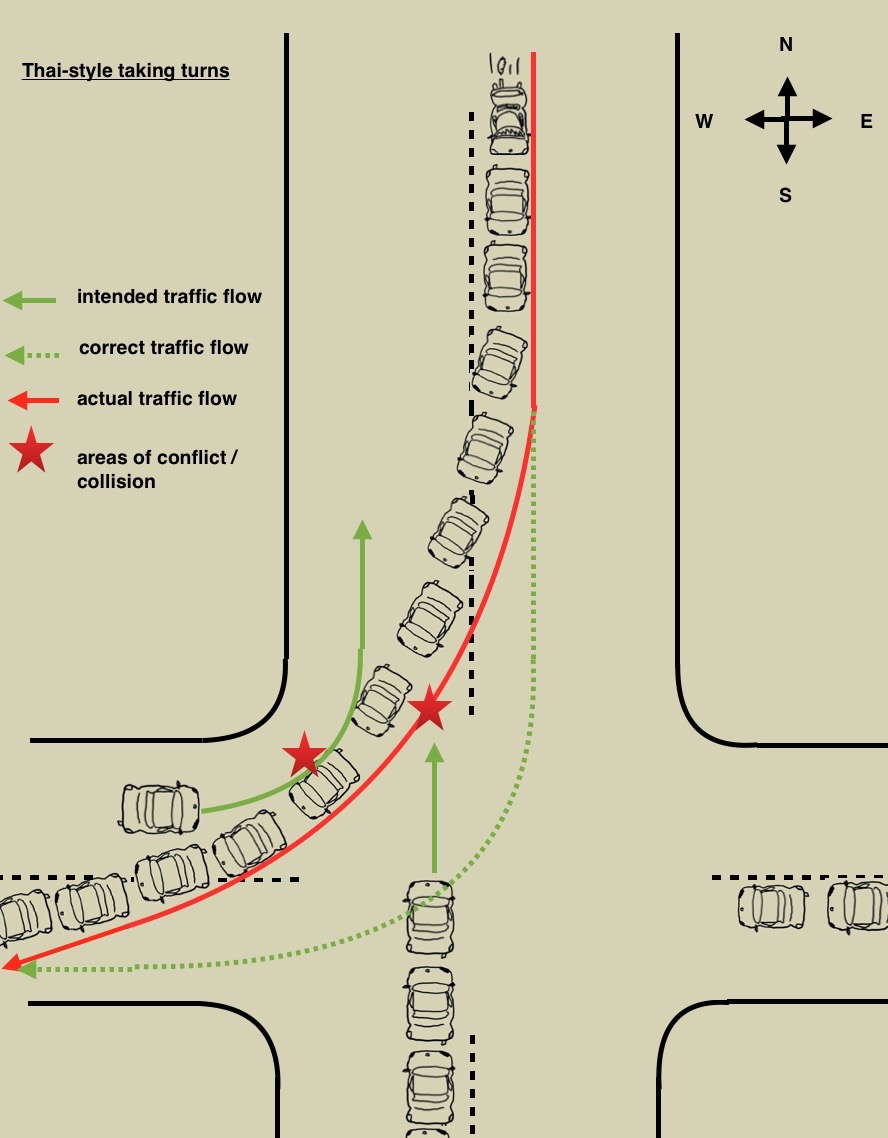
Many Thai people behave rather selfish in traffic in various ways: when queuing in a jam, many won't give space for incoming traffic waiting to join the main road (rather: they may speed up not to leave a gap and let you go first). When making turns, they just put their vehicle in the middle of the road to block traffic (and actually at times that is the only way to move onto a main road).
The Thai traffic 'rule' that prevails here is: whoever blocks the road goes first.
Now when you're in Thailand for a while, you may get used to this practise of blocking the road and going first, in fact you may find yourself doing it. But when you're blocking someone else on an intersection, and then curse him for not giving you way, while even thinking that he's wrong and you're right, then you know that you've been in Thailand for too long (I realized that recently about myself!).
6. RECKLESS BEHAVIOUR
Not all, but many Thai drive recklessly, with comtempt for danger and near complete disregard for consequences and the (social) environment.
Parents on a scooter with an infant in between their legs on the scooter crawling with feet nearly touch the ground, reckless speeding, drunk driving, dangerous taking over moves, etc. are all very common.
When traffic gets jammed, some vehicles get tempted to overtake the entire queue by crossing over onto the other lane on the inside of a multilane road, so by going against the traffic direction (in Thai: ย้อนทาง or ขับรถย้อนทาง or more commonly ย้อนศร or ขับรถย้อนศร = driving against the traffic flow / arrows). You can see this happening especially during the busy hours, when someone is in a hurry, or when someone wants to skip the entire queue using the lane of opposite direction to join it again at the intersection when the light turns green. Even a double line in between the opposing lanes which explicitly prohibits crossing it to take over does not stop Thai drivers from doing this (the difference between a single line and a double line in between the lanes of opposing direction is probably hardly noticed). Taking over using the lane with opposing direction can surprise other road users who did not expect this.
IF YOU ARE WONDERING WHY THAI DRIVERS DRIVE RECKLESSLY REALIZE THAT YOUR LIFE TO YOU IS PERHAPS MORE PRECIOUS THAN THEIR LIVES TO THEM
Reasons why Thai people drive reckless vary from simple foolishness to carelessness, not bothering about any consequences, which are typically Thai anyway, but some deeper factors are rooted in Buddhism, which in many societies has created not only a peaceful, tolerant and assimilative atmosphere, but wich has also instilled a sense of fatalism, complacency and a kind of passive acceptance of your role in the world into the people. This way, certain ideas can dwell into the Buddhist mindset that take away hope or motivation to change or control your life: 'I was born poor so I remain poor', 'I'll die when it's my time, I can't do anything about it anyway', etc.
Karma is the spiritual Buddhist spinning wheel that will bring to you in your life what you deserve, and although there is controversy over what it actually means, one side of interpretations removes the power of the initiative and the act of taking responsibility.
The Buddhist concept of passing through a sequence of lives can also lead Thai people to see less value and uniqueness in this single life that Christians tend to take so seriously.
All these concepts have over time ingrained themselves deeply into the collective mindset of many Buddhist societies and thus have become a silent root factor in the way people live.
Accidents happen, the cycle of life goes on.
7. GREY AREAS AND A LACK OF CONSENSUS
Because the implementation of rules has (to some extent) been left unclear and is not well enforced, and because most people don't stick to the official rules, grey areas in conduct are created and there is a lack of consensus about what is proper traffic behaviour.
One striking example of that concerns pedestrians crossing the road using a zebra which is sometimes marked by traffic lights. When such crossing is on a main road without an intersection, most Thai drivers are simply not used to the idea of stopping as there aren't pedestrians crossing over all the time. So they may simply keep driving even through a red light. This creates dangerous situations for foreigners who trust the green light, I've witnessed several near-accidents and one real accident happening like that.
The most dangerous situation happens on a two-lane road (going in the same direction) when one car stops for a pedestrian and the traffic coming from behind on the same land or the adjacent lane didn't realize that fast enough or didn't see the pedestrian.
8. HIT-AND-RUN PRACTISES AFTER AN ACCIDENT
Believe it or not, but Thailand's hit-and-run accidents are infamous. Sadly, many Thai drivers who caused a traffic accident try to flee the scene anonymously as soon as possible. Worse, in some cases they have even tried to kill the already injured victim so as to leave no witness and no claimant alive. The reason for this is because such persons probably don't have the right insurances to cover a third-party accident and to pay for medical fees and compensations of the victim being handicapped. Don't be surprised if you're hit in an accident and the other party involved just hands you your helmet, then takes off. You're probably already in a shock that you had an accident, so you may not have the clarity of mind to analyze what just happened and to print the license plate of the other party into your mind.
I can tell you what to do in case of an accident, but better make sure you're simply never involved in any.
9. THE MEANING OF THE ROAD
The road has a different meaning in Thailand than in say a typical Western-European country. To Thai people, the road used to be the common way to get yourself from A to B for everybody. Have a look at some old pictures of Taphae road in Chiang Mai and you'll see people walking with wagons, buffalos and in the past elephants too. Slow and fast, young and old, wheeled or barefooted, all used to transport themselves on the same dirtroad without any real rules other than just looking around and giving way to traffic that seems to come in front of you and taking the space to move when you can. Shops and houses would broom the dirt out and dust it all on the common road. That mentality hasn't changed much. The road is simply for everyone, so the entire concept of separating traffic by type for different types of road is actually alien to Thai custom.
The concept of highways was alledgedly developed by Germany in the worldwars of the previous century to allow tanks to move quickly from one spot to another, an important element of the so-called Blitzkrieg. Highways in the West are truly highways only accessible for traffic that can go at a minimum speed, but on the so-called Superhighway in Chiang Mai you find everything, from cars, agricultural trucks, scooters with less than 200 CC, even pushbikes and riding food hawkers, hey even people walking trying to sell you flowers or what be.
Again, this is a difference between Western culture and Thai culture. Western culture has become more analytical, and developed through distinction of matters, created rules, and people abide by those rules, almost more than they would adapt to a particular situation. In Thai culture, everything goes, there isn't a sharp sense for distinction, the rule is less important than the situation of watching each other, what the other does and adapting to or taking advantage of it.
So on Thai road, you find so many different vehicles, with different speed and traffic behaviour, that often the road just gets clogged up. While in the West, highways generally work because everybody drives the same speed, there are proper bicycle lanes, pedestrian zones, even areas designated for elderly or handicapped people.
In the West, we have developed through separation, in Thailand, everything is mixed together and you got to sort it out by watching your neighbour rather than by remembering a rule.
10. THE CONDITION OF THE ROAD
At first sight, roads in Thailand look pretty normal and good enough, but if you take closer look, the condition of the road actually reflects the state of society. It took me a few years to notice, but once you know, it's actually quite telling. Have you ever noticed that some of the sewage pits on the road are very deep? Some are located 10cm below the surface of the road. If you don't notice at night or because you're focusing on the traffic around you - trusting the road - your shock breakers could take a big hit and so could you, you could be thrown off your vehicle or loose some control over your gear, especially if you were driving fast. I kept wondering why they wouldn't level the lid of the pit with the road, and finally I realized why: it's because every few years, the road 'repair' department keeps dumping another layer of asphalt over the road, without bothering about the fundament. Quite often, they wouldn't even bother to fill up some holes first, so eventually the new asphalt layer would sink into those holes and the road will get bumpy again.
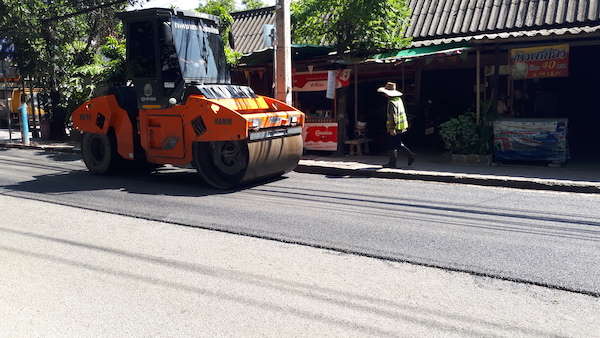
This is reflective of Thai society: in essence, there is no solid base, things are being quick-fixed as they go and everything looks nice and shiny for a while but from one problem follows another one. The many layers of asphalt are getting so high that the lid of the pit which was originally level with the road now has 'sunk' 10cm. If you carefully inspect the sides of the new asphalt layer, you'll notice how unfinished it actually looks and often the drainage gaps in the side of the pavement also get narrower and narrower because of all these layers of asphalt.
In more developed countries, they would even take out the old layer before putting on a new one, but most importantly, the authories would have invested in a proper and sold foundation of the road that has several components so as to last long and stay even. Not so in Thailand.
When you drive a little bit out of town, you can notice another thing, which is that the main road actually looks okay, but many of side roads and areas in front of shops that feed to the main road are not: they are dirt roads with sand or gravel and the problem of that is that all that sand and gravel ends up on the main road, reducing again the efficiency of the main road because now you can't safely use the shoulders of the road, risking slipping or sliding when you drive fast and need to make a turn or a quick stop.
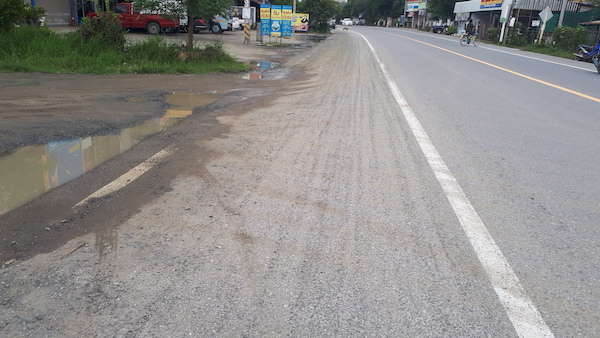
Besides that, roads in Thailand are far more dirty than roads in the West. This is mainly due to use of less clean fuels, that sedimentate on the surface like a black and slippery coating. How dirty the roads are you can see if you walk around town on slippers: your feet will be black by the end of the day. Especially after a light shower of rain, this creates an extremely slippery road condition, so after rain you got to be extra careful when taking turns. Don't lean too much into the curve. Finally, there can be all sorts of trash on the road, people just wipe dust and rubbish and dirty water out of their houses onto the road instead of disposing of it properly and being really social to others.
So the lack of will to invest in a proper foundation makes the system less efficient, more dangerous and fragile, with a need to 'maintain and repair' it constantly. Isn't that the same for Thai politics, Thai education, business and law? It's simply the type of stuff that makes developing countries developing countries, with a twist for what is uniquely Thai.
What does not work so well in Thailand?
Although you should not forget international traffic rules, in order to stay safe you have to adapt to the local situation and you will soon find that a lot of proper international traffic rules almost don't apply or can even bring about more risks in Thai-style traffic.
For example:
These are a few of the most remarkable features of Thai-style traffic that are probably different from what you're used to. Besides that, almost everything you can imagine could go wrong goes wrong.
Realising that will help you not only to understand more about Thai culture, it can also keep you safer.
III. Thai authorities' response to Thai traffic behaviour
Thailand has adopted international traffic rules, but Thai authorities of course have come to realize that not all international rules go very well with Thai culture and traffic behaviour, so they have made alterations aiming at improving traffic situations in a way which is more suitable to Thai drivers.
Unfortunately, not all of them work well.
a. U-turns
The many U-turns you find on main roads are an example of that: they are an alternative to having an real intersection. Real intersections in Thailand suffer from the problem that Thai drivers tend to speed up last-minute to push through the last seconds of the green light or the beginning of the red light, thus delaying the traffic coming from the next green light. Also, sometimes traffic doesn't flow through and just parks in the middle of the intersection.
Energetically, intersections embody direct confrontation and demand either complying with the rules or making decisions, all of which don't go that well with Thai culture.
The U-turn is Thailand's response to that, it allows traffic to gently blend in with the current flow, in other words: it is the Thai alternative to let people interact more harmoniously and it is much more suitable to Thai culture than open or guarded intersections.
In most cases, it actually works. But it can get irritating if you have to drive a few kilometers before you can change direction.
For this reason, I usually refer to Thailand as the Land of the U-turn, not the Land of Smiles as most tourist bloggers rave about. I've found smiles in for example Burmese people more genuine.
THAILAND IS THE LAND OF THE U-TURN NOT THE LAND OF SMILES
b. One-way traffic
Making roads one-way only is another example of how Thai authorities try to improve traffic flows to cater for Thai-style driving. Often it's actually a proof of inadequacy because not enough urban planning was done before and now the only tool left in the hands of the desperate Thai authorities is to think one-way.
Unfortunately, often it doesn't really work.
Especially in the busy hours of the late afternoon, when parents pick up their kids from schools and early workers go home, Thai police come out to main intersections to "regulate" traffic manually that should be done by a computer rather than a human, and often they make the traffic flows go worse. Whenever you notice the traffic is not flowing around 4 or 5pm, you'll often notice that the reason was a police guy redirecting traffic a few hundred meters further on.
Turning things one-way is typically Thai: it means you didn't plan for things properly and now you've gotto pay the price.
c. Creating unclear traffic situations
In some locations, Thai authorities have reversed the direction of lanes aiming at improving traffic flows, which may be effective at most times of the day, but such reversal can confuse Thai drivers who didn't pay enough attention and so lead to accidents, especially if not well-marked or well-separated.
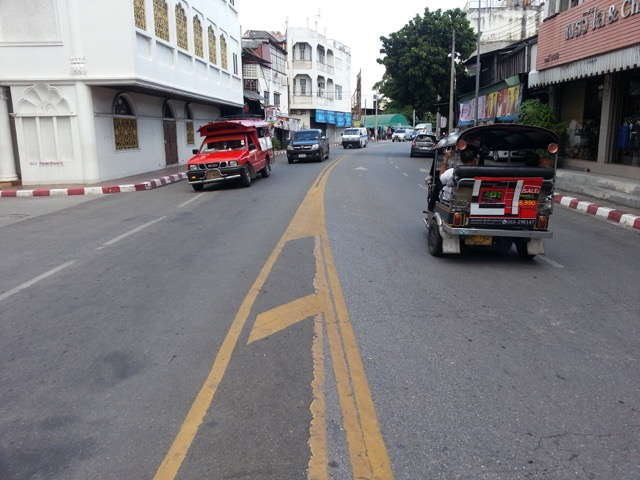
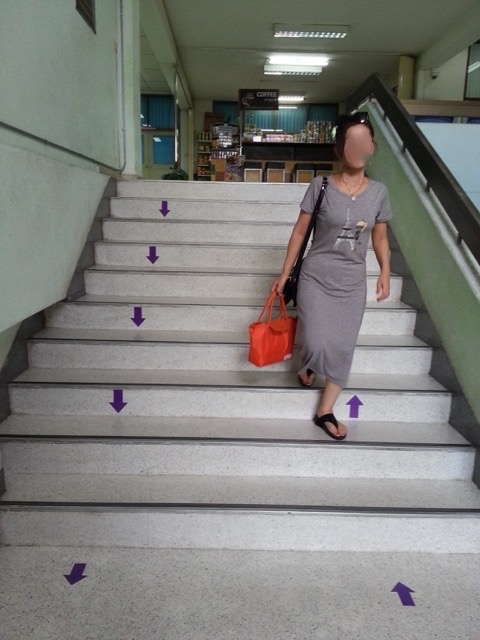
Another reversal of traffic flow failure of the Thai authorities is the marking of bicycle lanes against the traffic flow of some main roads. This was probably done to promote Chiang Mai as a "Bicycle City". The reality is that not many cyclists use these lanes, but instead motorcyclists often use it while they are not supposed to, and a lot of car drivers simply ignore the lanes which creates the chance of crashing into two-wheelers.
IV. How and why do most accidents happen in Thailand?
Accidents happen, and in Thailand accidents happen A LOT. In Chiang Mai only, I witness an average of 1-2 accidents on the road every month (!), meaning that I either see it happening right in front of me or I pass a place where an accident just happened minutes ago and the victims are still lying on the road. Besides that, I see near-accidents happening nearly every day, cars driving at centimeters aways from each other, and you can see the white chalk marks by the police nearly everywhere on the roads.
Dealing with injuries of traffic accidents is year-and-again in the top three of main activities in hospitals.
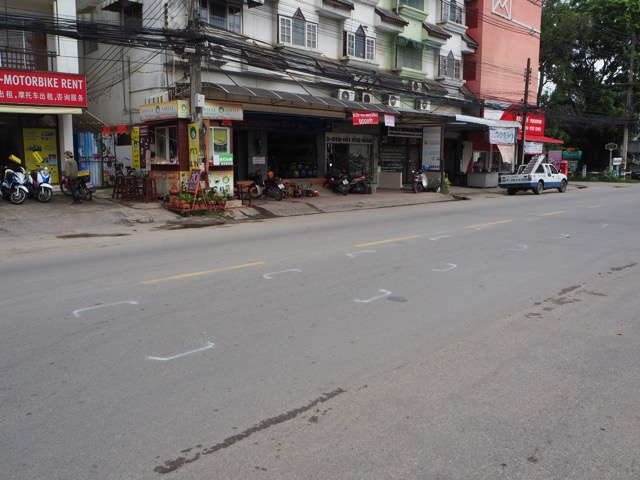
It's hard to get hold of official statistics, but a few common causes for accidents are:
In a recent article the BBC summarized the situation of death and accidents on Thailand's roads, confirming that it's due to a combination of lack of government action and enforcement and Thai people simply not following the rules.
POSSIBILITIES OF A TRAFFIC ACCIDENT
Here are some either typical traffic accidents that could happen in Thailand, or traffic accidents that you would not expect to happen:
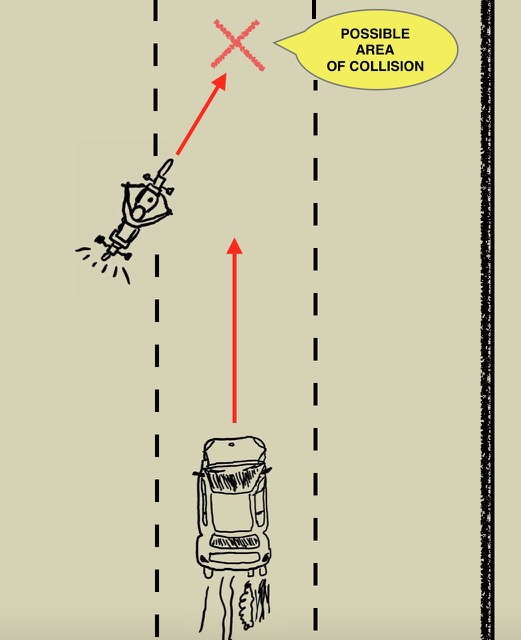
Driver A is waiting for the car from the opposite direction to pass before making a right turn into a soi. Driver B can't wait and crosses the middle line (sometimes even a double line) to over take driver A. At the moment that driver A wants to make the turn, driver B hits into driver A. Driver B is wrong to overtake driver A when driver A is clearly signalling to be on the verge of making the turn.
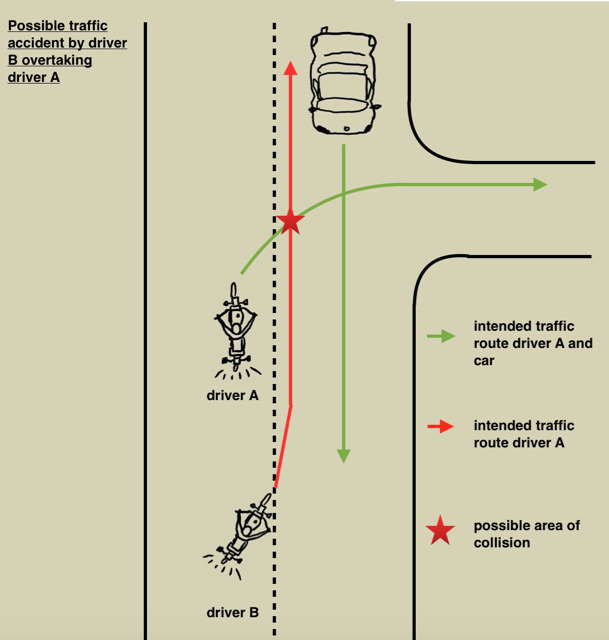
Driver A is waiting for the car from the opposite direction to pass before making a right turn into a soi. Driver B can't wait and crosses the middle line (sometimes even a double line) to over take driver A. At the moment that driver A wants to make the turn, driver B hits into driver A. Driver B is wrong to overtake driver A when driver A is clearly signalling to be on the verge of making the turn.
Lesson: always check your mirrors and shoulder even in situations where you would not expect to need that.
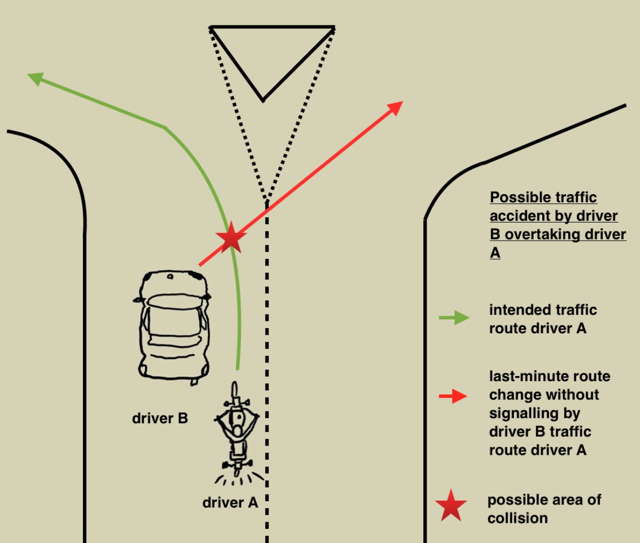
Driver B is in the left lane which leads to a left turn on a T-section, so driver A anticipates that driver B is making a left turn on the T-section just like him. However, driver B changes direction last-minute without signalling or by late signalling and collides with driver A. Driver B is wrong, but because driver B is still a littlebit in front of driver A, Thai interpretation might put some responsibility on driver A.
Lesson: antipicate how traffic behaves but also anticipate mistakes of others and put most of your attention in front of you.
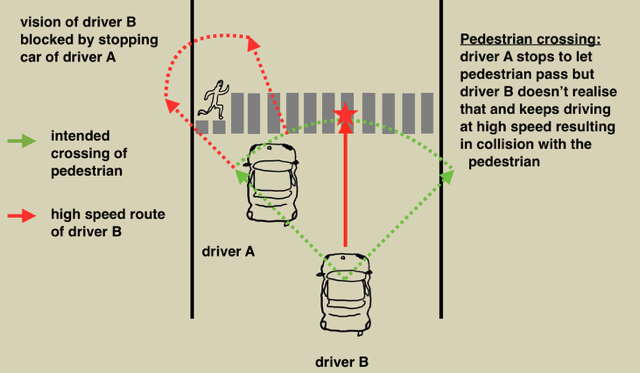
Driver A stops in front of a pedestrian crossing to let a pedestrian pass. Car driver B isn't alert enough to realize that driver stops for a pedestrian and keeps driving at high speed to collide into the pedestrian. The situation is even worse if the pedestrian is running to cross the busy road because then he appears very suddenly into the vision of driver B from behind car driver A.
Lesson: whenever someone stops on the road, realize there might be a reason and that you don't have full vision. When you're the pedestrian, make sure that you are seen, don't run but move predictably.
V. How to stay safe?
Being aware of the main Thai traffic "rules" I set out above and how they deviate from international traffic rule, you will be better equipped to stay safe.
Remember how much your value your life, your health and your time and realize that many Thai drivers may not value these things as much as you do.
When you engage in Thai traffic, be prepared to take on a double work load: think for yourself but also think for others around you. Not only do you have to look out in the normal way that you are educated to do, you also have to anticipate Thai drivers' mistakes. This is true not only for traffic, but also for all kinds of other situations, especially if you work with Thai people: you have to anticipate what could possibly go wrong.
1. Focus on your Range of Responsibility
While not neglecting your international driving rules' obligations to watch out 360 degrees around you, in Thai context mainly focus your attention in front of your vehicle. You need to put about 80-90% of all your attention in front of you within your Range of Responsibility. Correct international driving behaviour would put perhaps 60% of your attention in front of you and 40% of your attention around you, because this is also part of your responsibility. But in Thailand, you have to break with this habit because everyone else also does so and it's especially in front of you where accidents can happen suddenly all the time.
2. Drive and move predictably, be seen
Don't make sharp or sudden turns. When changing direction, signal and move gently. It's all about being seen and being predictable to your fellow road users so they can adapt to you.
In an international driving context, you are supposed to adjust your speed at the proper level: at times slower and faster where you can, you could even fail your exam by not driving fast enough. You're supposed to make smooth and fast turns.
In Thai context, this doesn't always work out well. Making a sudden quick turn or a sudden movement outside of your steady 'cruise-controlled' pace could surprise other road users who were anticipating your predictable behaviour.
For example, some in particular young Thai scooter drivers take over at very high speeds, zigzagging around other vehicles, often even without helmet. This irresponsible behaviour can only go unpunished when all other traffic is predictable. In such case, if you would make a sudden movement, however correct in international driving context, you become unpredictable to them, and a collision might happen. Even if it wouldn't be your fault, you don't want to get involved.
Another example is how some pedestrians, after having waited for a long queue of vehicles to pass, suddenly try to cross a road running when they see an opening in the never-ending traffic. They might be noticed by one vehicle but not by another vehicle which comes from another lane. Even when crossing a lane as a pedestrian, walk over in a composed, predictable manner making sure that all other traffic sees you, especially the second land you're crossing. Making a short sprint can only be safe when you are absolutely sure that there is no one left to hit you.
TO SEE AND TO BE SEEN THAT IS THE QUESTION IN STAYING SAFE IN THAI TRAFFIC
In the same way, don't stop to abrubtly. Try to stop slowly, so the traffic behind you can notice. Stopping in situations that the traffic behind you doesn't expect, for example if you want to exhibit gentleman behaviour for a pedestrian waiting to cross the road, can cause the driver behind you to hit you in the back.
Pay special attention when you know you're in someone's blind angle: quite often, cars suddenly make sideways moves and when the driver is too lazy to look around, you could be in his blind spot.
When you make sure you're seen (or even make eye contact), you may also sometimes notice that the rude anonymous behaviour shifts somewhat towards 'being krengjai'.
3. Don't trust traffic rules, but watch actual traffic behaviour. Anticipate traffic, but in the right way.
Do cars really stop at the zebra?
Anticipate how traffic, especially in front of you, will behave, rather than trusting that everybody follows the rules.
On many intersections, the lights turn green in a fixed sequence against the clock, but on some major intersections in Chiang Mai (Airport Plaza intersection, Rincome intersection, etc.), it's completely different, so don't anticipate the normal sequence and take off before the light turns green but actually watch.
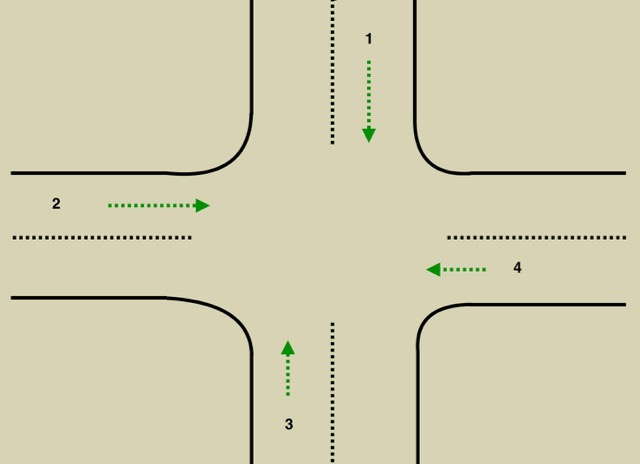
4. Don't trust the roads
Generally, roads in Thailand are pretty good and comfortable to drive, main roads outside of the city can often be surprisingly good, so you can make great outings out of town. But in contrast, some parts of the roads inside the city can be pretty bad, with sudden and unexpected unevennesses or even holes in the roads. The lid of a sewage hole is suddenly much lower than the road surface, or the road has simply worn off with big holes and no one to take care of it. Especially when you're driving at high speed and expect a smooth road, hitting such a hole can bring you off your balance.
Some foreign drivers with lots of driving experience got killed in Thailand driving into caves in the road where they didn't expect it.
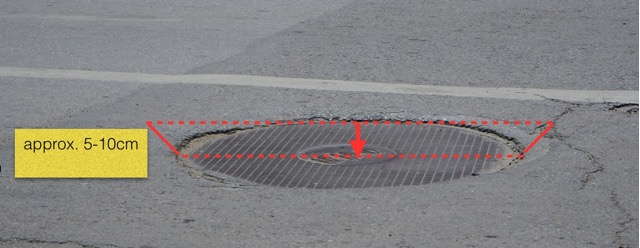
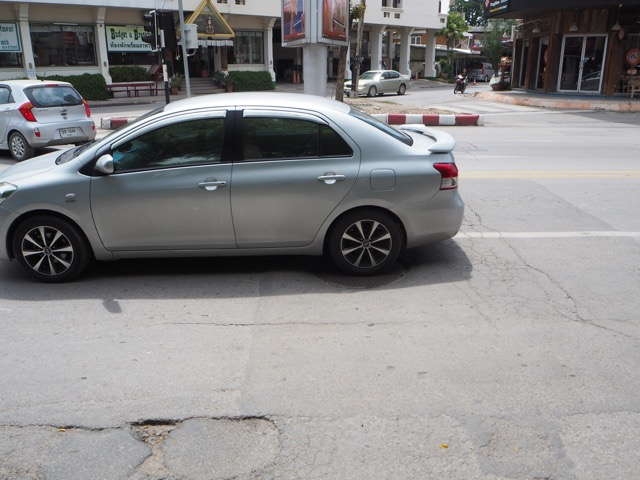
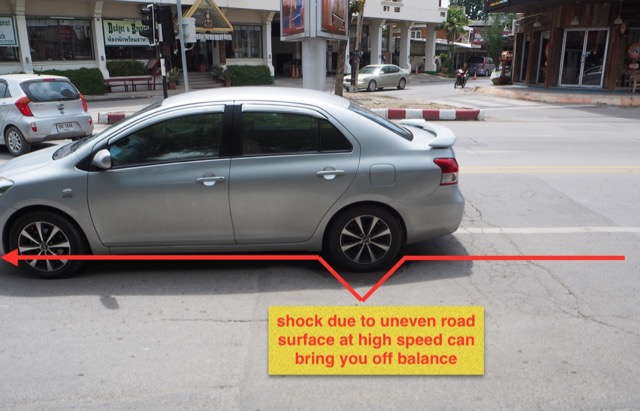
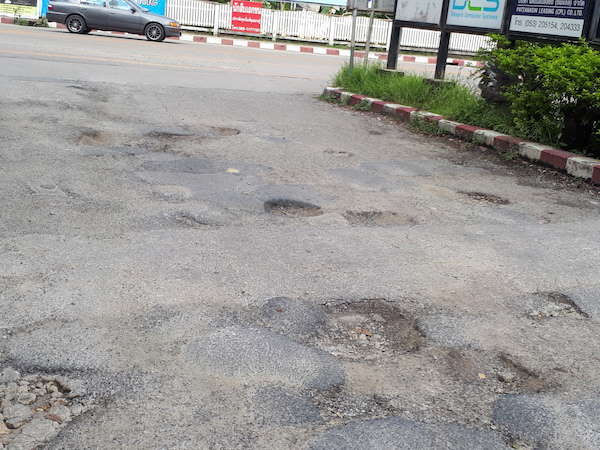
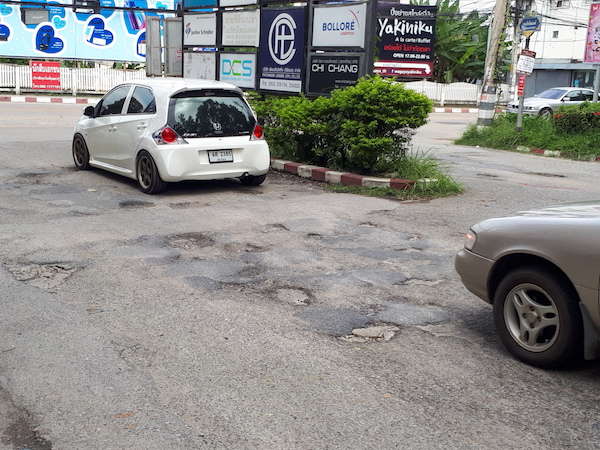
5. Adapt your changing lane or changing direction procedure
In international driving, you should have learned to:
Thai style driving context is different from international context in that you always have to be careful that no one is passing or overtaking you from the wrong side / angle. If you turn left, you not only have to check your right side (which is normal), but also your left side, because someone might just want to pass through going straight on your left.
Another difference is that you should not leave the signal on for too long. In international driving, you can leave the signal on for a while, traffic will notice and pass and you change lane or direction after you are able to do so.
In Thai context, this may not be the case. As soon as you signal, other drivers behind you are on alert as you are going to make a move which is within their Range of Responsibility. So you may find that the traffic behind you is waiting for you to change lane, whereas you're used to international traffic to simply pass.
So, don't signal too early. First check how much traffic is behind you. If you keep the signal for too long, you are 'disturbing' some road users behind you who are waiting for you to change lane or make a turn. If you keep it on for a very long time traffic behind you may think you have just forgotten that you left your signal on.
Signal, watch, and take action on your signal. Don't wait too long to take action on your signalling to others.
6. Don't drive too fast
Within the city, don't drive faster than say 60-70 km/hour but adjust your speed all the time especiallly depending on how busy it is in front of you. Make sure you have maximum visibility and try to anticipate all kinds of traffic: pedestrians suddenly appearing from behind cars, scooters joining in the road without even bothering to look, road users in front of you who suddenly stop in the middle of the road 'for no reason' while you were just looking behind you, etc.
You need some margin in time to react, especially to adjust to other people's mistakes.
7. Don't lean in curves
Roads in Thailand are generally good but there is more pollution including some petrol sedimentation on the surface of roads, which can become slippery especially when it rains. Also, some shops clean their own floors with soapy water and then throw the water on the road, which may make it slippery.
By leaning into the curve, you make yourself more fragile to loss of balance in case of slipping. Also, it's much harder to stop properly when you're in a leaned position in case you encounter another vehicle as your gravitational point is not straight above your tires, then stopping abrubtly will lead to slipping.
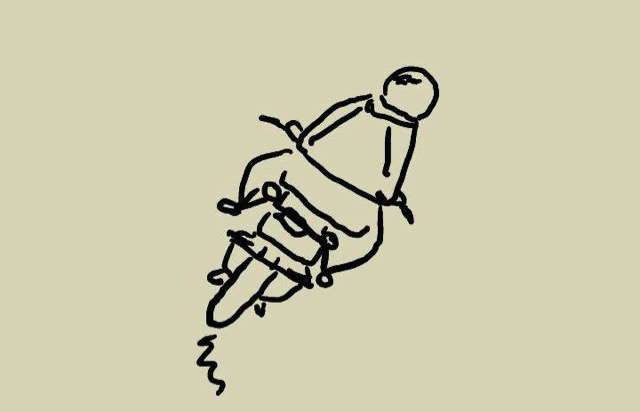
8. Wear at least a helmet and proper shoes, if possible also other protective clothing
Thailand is a hot country during most of the year, so it's tempting to step on a scooter with flip-flops and hair blowing in the wind. In accidents though, a helmet is the most crucial piece of protective clothing that can save lives and serious head injuries. The second most important is to have proper shoes.
Although almost standard in some other countries, gloves are often too much bother when you're just driving in the city. Besides that, long pants are actually better than short pants, not only as a protection against falling and scratching, but also against sun and mosquitos.
Besides that, nearly the only thing Thai police are actively enforcing is wearing a helmet. If you stay in Chiang Mai during about one month, chances that you pass a checkpoint checking on helmets are quite high (penalty officially about THB 400).
You can buy simple Thai quality helmets at a few hundred baht or very high quality ones at several thousands. Both will at least give you the most important basic level of protection.
If you drive a big bike and go around or out of the city at much higher speeds, all of this becomes much more serious and you should definitely at least wear proper shoes, gloves and helmet.
9. Get a proper accident insurance and get your vehicle insurance
Most of the popular large banks in Thailand offer an accident insurance, in particular the one by Bangkok Bank is well-known amongst foreigners but other banks in fact provide nearly the same offer.
An accident insurance usually covers a substantial amount of damage in hospital bills (around THB 50,000) at a very modest price (about THB 1,000-2,000).
(The insurances are usually underwritten by an insurance company that the bank teams up with, so the bank just serves as a counter.)
Besides that, if you own a vehicle you should pay for your government license every year (just a few hundred baht) and when you do that, they will require you to have your vehicle inspected and get an obligatory accident insurance as well (just THB 100-200).
10. Don't be over-confident and don't trust
Perhaps the most important of all is: don't be over-confident. When you just start to drive a motorcycle or vehicle in Thailand, you may feel everything is under control, you're enjoying the roads or the landscape and you may become over-confident.
I had three minor slipping accidents in my time of driving here, and they all happened in the beginning because I felt too confident about driving and trusting the road or others.
Driving too fast, hanging in the curves, trusting the surface of the road, and trusting others to follow the rules can all come from over-confidence and will lead you into trouble.
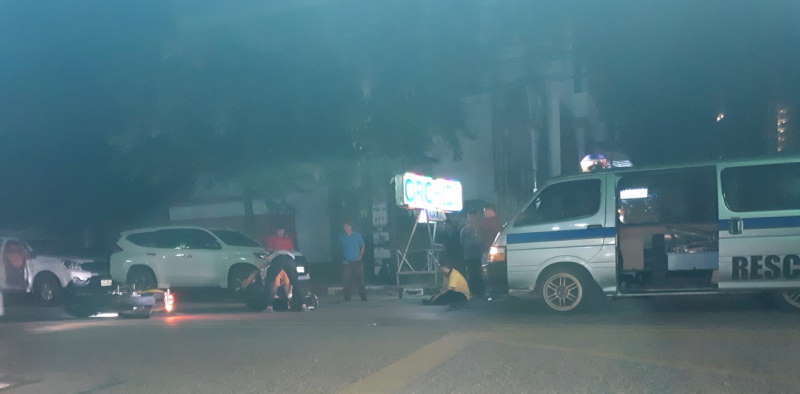
11. Get your Thai driving license?
To me, getting a Thai driving license is more of a legal necessity than that it will really help you to stay safe. Yes, you'll learn some things that the driving license office will test you on, but they won't teach how Thai people really behave on the arena of the road.
Passing a motorcycle or car driving license exam in a strict country and then applying this knowledge to the situation here has helped me to understand more about how Thai driving practise actually deviates from the international norms, and how to stay safe.
Don't forget, a Thai driving license cannot be converted to many 'stricter' countries, but vice versa it's possible.
Hopefully, these guidelines will help you to stay safer in Thai style driving. However, other dangerous situations occur with foreigners who pick up Thai-style driving habits and then take it to the extreme, which can be more dangerous than the 'predictable' Thai behaviour. Also, more and more Chinese tourists are appearing on the road, showing even more irresponsible driving, parking and studying maps in the middle of the road, etc. These drivers again have another driving style so they create yet other traffic situations which differ from Thai-style.
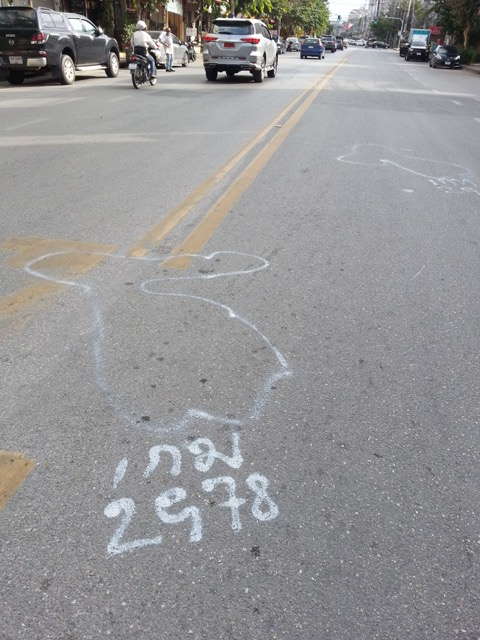
Note 1: For the sake of style and simplicity, in this article I use generalisations such as 'Thai people' or 'Thai mentality' and so on to refer to what I have observed to be mainstream behaviour, but I am very well aware of people who don't behave in certain ways. Where I write 'Thai people' or 'Thai-style driving', I mean 'many Thai people' or 'most Thai people' in general ways that I have observed. This article is therefore not in any way meant to be racist or discriminatory.
Note 2: For convenience, in this article I refer to the driver
Kenny Wong for CM Locator